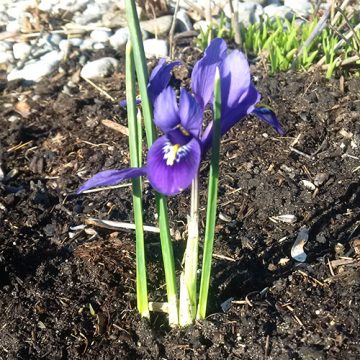April showers bring May flowers. Crocuses will beg to differ. As will Snowdrops, Siberian Scilla, Hellebores and Dwarf Iris.
The first three months of 2017 are going down in the record books as the warmest ever. That may have nudged forward the bloom time of a few spring flowers, albeit only by a day or two. These delightful blooms pop out of the ground at the first inkling of spring, sometimes as early as the middle of March.
Unlike the groundhog that has the option of scurrying back into the earth, these flowers can’t turn back. Once they show themselves to the world, they are committed. We gardeners might worry over the fact that their tender leaves and flowers may be exposed to a wicked March or April snowstorm, but we shouldn’t fret. They are strong enough to handle anything Mother Nature might dole out.

Crocus
Crocus is a cute early spring blooming bulb that will often be in bloom by the first official day of spring. I have even seen Crocus defy the odds by blooming in February if growing on the warm south facing side of the house. Crocus is a bulb that needs to be planted in fall in order to perform in spring. Plant them 3 or 4 inches deep, and they will grow about 6 or 7 inches high. Enjoy Crocus in white, yellow, purple and pink.
Crocus is a good companion for summer flowering perennials or spring flower gardens. Crocus will bloom early in spring and then quickly disappear, making way for later blooming flowers to follow. Like tulips, once crocus are planted, they can be enjoyed for many years, with little input from the gardener.
Snowdrops will poke through snow in March with no regard for the weather. Appearing overnight, their pure white blooms droop downward in haphazard form. Snowdrops are perfect for woodland settings. Like crocus, they should be planted in fall.
Siberian Squill, another bulb, is a short plant that is often seen in abundance along ditches and in woodland settings. Flowers are tiny, but put on a dramatic show when growing in groves. Blooms will disappear in mid spring and leaf stems will remain in place until mid-June. Siberian Squill is most often blue but also found in white.

Siberian Squill
Dwarf Iris is similar in all ways to its bigger sister, but much smaller. And while traditional Iris often called Flags, blooms in June, Dwarf Iris blooms in late March. Take a close look at the bloom of Iris and you will be impressed with their variety of colours and intricate petals.

Dwarf Iris
Last on my list of March blooming flowers is Hellebores, which despite its unattractive name, produces attractive blooms in several colours. A true perennial, Hellebores, or Christmas Rose, grows in clumps, nearly a foot high. Plant Hellebores near the house where they will be noticed, because their buttercup type blooms hang mysteriously downward, partially hidden in its own foliage.


